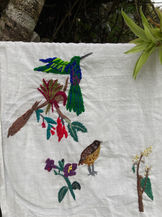top of page
ANA MARIA ZAMORA
La Macarena
Memories of la Macarena tropical forest. A canoe travelling through the Duda River with a dead person: Sixto, the last Tinigua indigenous.
I lived in la Macarena tropical Forest in 1999. I went back in 2017 to work in a rural educational Project.
These embroideries were made in 2018, remembering la Macarena and honoring the last Tinigua indigenous- Sixto, who survived the mass killing of his tribe in 1949, during (one of) the violence times in Colombia. He lived in a place where we as biologist have to spent one night before reaching the Biological Station in 1999. The death of 300 Tinigua indigenous was the result of a colono who wanted a woman from the tribe.

Contracorriente
Migrating against the water current
Years ago, I had done research with fish. In the costurero I did in July 2022 in the Museo del Río Magdalena, we talk about types of migrations fish do, that can be short (less than 100 km) , medium (between 100 and 500 km) and transnational (reach 3000 km), and the environmental pressures fish face. Fish migrate for food and reproductive spaces. Participants talked about their own migrations and displacements. I began embroidering fish in a fabric that mixes fish from different Colombian ecosystems. The threads are silvered and golden and mixed with cotton-colored threads. Silver reminds me of mercury fish carry on their bodies as a consequence of gold extraction along the Colombian rivers. Mercury duplicates the permitted levels in kids and persons that live along the rivers with gold extraction.
As fish do, we all migrate.

El Silencio- Home
El Silencio is the place I live.
In this place water flows pure. Is two hours away from Bogotá. I been doing small embroideries of animals and plants, as a silence process to understand the physical taxonomic characteristic of the plants and animals that surround me, as a way to study their names and forms. With artists Esteban Borrero and Gabriela Borrero we take care of the reserve and invite artist an persons to do workshops.
Embroideries are of the birds we see the most. And sacred plants used by native communities for protection and natural medicine.
Birds: Comprapan (Grallaria ruficapilla), Colibrí tominejo, pava andina (Penelope montagnii), Tangara vientre escarlata (Anisognathus igniventris)

La Chagra
In may 2022 I travel to five communities along the Igara – Paraná River in the Amazon, a Huitoto indigenous territory to do embroidery and graven workshops with artist Esteban Borrero and in collaboration with Espiritu de Abundancia, Fondo Acción and Sabha Gourmet. We talk about the Chagra, the place where food is cultivated. During the costureros the topic of sacred plants emerged. I embroidered a yanchama, a natural fiber, with the sacred plants: Coca, yuca, tabaco y ají Cultivated in la Chagra.
Memories of the environmental pressures amazon forest face were embroidered in a caw with golden udder, placed in the middle of Chiribiquete sacred place.
Grandmother Soledad, in the Igara Paraná river taught me that a slow work, as the one she does daily in la Chagra is the way to take care of the world and the family.

Bad
In November 2022 artist, writer and Curator Humberto Junca invited different Colombian artist to copy an LP to make an art piece. The exposition was called Piratería Sentimental 3. I did the cover of BAD- from Michael Jackson. It made me reflect on the softness and dedication embroidery has in contrast to the title of the disc- BAD. It is also a reflection between the relation of art and artist. Michael Jackson is one of my favorite singers, but I also thought about his life when I was doing the embroidery.

bottom of page














